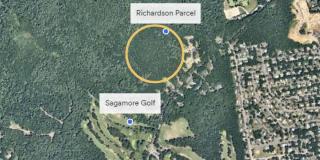Richardson Green parcel - Residents Weigh In

This article appeared in the January 4 edition of The Daily Item - ItemLive.com and is reprinted in its entirety here.
By ALEX ROSS
LYNNFIELD— The Select Board moved to take the future of the Richardson Green parcel under advisement Monday night following a public hearing during which residents voiced their opinions on the land.
Under Massachusetts Chapter 61B — the state’s right of first refusal law — the town can either purchase the land for conservation at a price tag of $2.7 million, or it can assign that right to a non-profit organization, such as Essex County Greenbelt. Should the town choose to do neither, the land, located between Sagamore Golf Course, Ipswich River and the town’s water district wellfields, will proceed to sale for the development of housing.
Among the many residents who spoke during the hearing in support of purchasing the land was Kirk Mansfield, a member of the Lynnfield Historical Commission. Mansfield said that Lynnfield is becoming increasingly overdeveloped, and that preserving Richardson Green will help the town retain some of its charm.
Selectman Phil Crawford said that given current circumstances, the town is not looking to spend such a hefty sum of money on the parcel. Allowing the land to proceed to sale with developer Angus Bruce, however, is also not ideal.
“Nobody really wants the development,” said Crawford, referring to Bruce’s plans. “The town doesn’t need 16 more homes when there’s already a school capacity issue.”
Kevin Sullivan of the town’s Finance Committee suggested a way around the capacity issue. He believes the town should buy the parcel, but that it should use part of the land for L.I.F.E. (senior citizens) housing. This way, he said, the town could recoup some, if not all, of the money it would have to spend in order to purchase the land without adding students to the schools.
Planning Board Member Kate Flaws spoke further on the issue of the purchase price, explaining that the town is not expected to bear the entire cost burden. There is already $200,000 set aside for the effort thanks to the Conservation Commission, and Flaws noted there are numerous opportunities for private fundraising and public grants for up to $1.25 million.
Bruce disagreed. He sees virtually no ecological benefits to the land, and, on residents’ worry over the town’s already taxed water supply, he said the issue will be fixed 18 months from now.
“There is no environmental plus to this property. It’s a marginal forest,” he said. “And the idea that the additional septic systems would have a significant impact (on the town’s water)] is not correct. The perception that this is a critical piece of land is being misconstrued.”
Still, more than 80 percent of respondents in a November town-wide survey felt it was “very important” that the 20-acre parcel remains as undeveloped forested conservation land, with the majority of respondents believing the Select Board should exercise its right of first refusal to purchase the property.
The town normally would have had a period of 120 days to act, but, in the wake of COVID-19 and Gov. Charlie Baker’s subsequent state of emergency, the town now has 210 days— after the state of emergency ends, whenever that may be, said Crawford.
Alex Ross can be reached at aross@itemlive.com.

